Report From Banda Aceh (January 8-9, 2005)
BY TAN JO HANN
Tan Jo Hann filed the following report after spending 3 days in the ‘ground zero’ area, 500 kilometers from Medan City. The delay is attributed to inaccessible and unreliable telecommunication facilities.
Day 4 (January 8, 2005)
After Day 3, the SEAPCP-KOMAS medical team made their way to communities of ‘house-refugees’ providing mobile medical treatment, while the rest of us traveled to Banda Aceh.
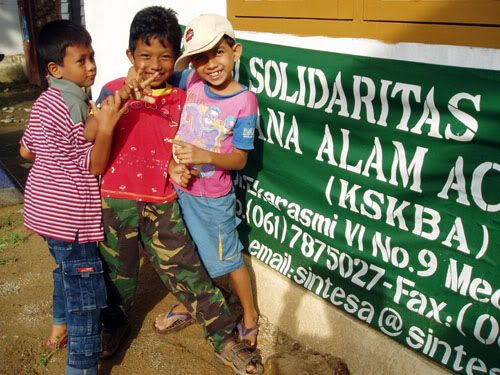
KSKBA Posko in Banda Aceh
A four-wheel drive was rented for this purpose. Contingents of trucks and other vehicles overtook us constantly, carrying an assortment of aid from various international and local relief agencies. An assortment of Indonesian military vehicles passed by us too, mostly filled with heavily armed soldiers and some with engineering equipment.
This main trunk road was obviously not built for such traffic as witnessed in the last ten days after the tragedy struck Aceh. It was a long and arduous 12-hour journey.
First stop at POSKO in Langsa
Koalisi Solidaritas Kemanusiaan Bencana Alam Aceh Sumatra Utara (KSKBA) or the Solidarity Humanitarian Coalition for the Natural Disaster was our local coalition handling the Aceh emergency relief operations.
We stopped by Langsa, a small agricultural town about four hours north of Medan. Although Langsa was not directly touched by the tsunami, it housed a steady influx of refugees. They traveled 300km (8 hours) from the affected areas.
A local partner of the KSKBA coalition - Biduk Alam - coordinates Posko Langsa (Langsa "aid station"). 40 volunteers with varied backgrounds manage Posko Langsa – there were laborers, civil servants, and skilled craftspeople of Langsa. Their weekly shifts and tasks were rotated and divided to manage their own personal and working life alongside with relief-work.
Active since the second day of the disaster, Posko Langsa distributed aid to about 4,000 displaced ‘house-refugees’, over 400 of whom are children. Distribution was not an easy task, as refugees are spread out among 52 different community houses over a 5-10 kilometer area.
Perhaps more alarming is inadequate supply of food. Although donations are received from neighboring shops and local communities, this too is insufficient to meet the needs of all the 4,000 refugees.
Second stop at POSKO in Meunasa Drang

Two kids looking at the eroded beach front at Menusa Drang
This is an affected area located between Lokseumawe and Bireun on the north-eastern coast of Aceh, where more than 100 houses were destroyed. These families are now housed in a temporary refugee center in the compound of a mosque. Living conditions and facilities are relatively better as compared to that of other areas, refugees appeared to be sufficiently-fed and well- clothed.
The local school was ruined when the tsunami struck, and many houses were caught in the 3 meter flood that occurred then.
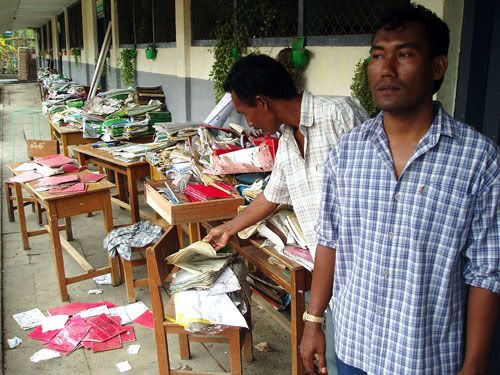
School ruined in Meunasa Drang
Fishing is the main livelihood of most families in Meunasa Drang. The eroded sea-front appeared to intimidate the locals, and most of them are now apprehensive or fearful of returning to sea. Also destroyed alongside their living quarters were fishing equipment and the livestock they once bred, eg. chickens.
“The older people in this area believes that the tragedy occurred because the society in general have been losing the traditional values and moral and it is Allah who bestowed this punishment upon us to warn us to go back to the path of righteousness”, said the local leader Mr Amrun.
“We need to quickly help the fishing families rebuild their lives by constructing their boats, buy nets and motors so that their lives can resume normally again,” said Mr. Ismail, the coordinator of the KSKBA Posko at Meunasa Drang. The local community leader also added, “We have many skilled boat makers here who can make these boats but we need some help from outside.”
Final Destination at Banda Aceh at POSKO Leung Bata
It was almost midnight when we reached the Banda Aceh Posko at the Tengku Luang Bata road, a few kilometers from the devastated town center.
The KSKBA posko handling aid distribution here in Banda Aceh played host to the five of our medic team from SEAPCP-KOMAS. The medic team was exhausted from their first day of visiting and treating almost 2,000 patients from five different communities.
Most of the patients needed only the most basic of medical attention. They were treated for cough, fever, infection of superficial cuts and bruises, skin irritation, and dressing of wounds. The more serious cases were forwarded to hospitals of medical treatment centers operated by larger medical relief agencies in the city center.
These survivors cannot afford to travel to these larger centers, nor did they have access to transportation - the disaster robbed them of everything, except for the clothes behind their backs. (Note: The medical team will post a comprehensive report after the debriefing tonight)
We set up base in the KSKBA post which is managed by a team of 5-7 volunteers mainly students from Aceh and other parts of Sumatra facilitated by the KSKBA. They handled the food and distribution of aid collected by the KSKBA coalition.
Day 5 (January 9th. 2005)
Kota Banda Aceh Wiped Out
The next morning, one of the KSKBA coordinators said to us in jest before we left Medan for Banda Aceh, “Good luck on your pilgrimage.”
Visiting the oft-photographed ‘ground-zero’ area was surreal, not unlike that of sensationalized news and features carried on local television stations or anything like the pictures displayed by then mass media.
Driving straight into the devastated town center, we saw a solitary mosque – Masjid Baitul Rahman – amidst a totally flattened and destroyed town.
The city was full of activity, if in a rather abnormal and morbid manner. Tractors, bulldozers, trucks and emergency relief vehicles were busy, as were the members of the press. It didn’t help that it rained the night before – the view was covered with a layer of grime, mud, and sand.
Even though it was two weeks since the tsunami hit, Banda Aceh was still clogged with debris from destroyed vehicles, houses, commercial buildings and schools.
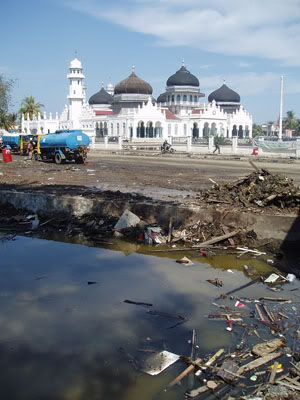
Mosque surrounded by destruction
There were eyewitnesses who reported that the raging flood water swallowed up whatever that stood in the way, but slowed down when it was approaching the mosque. The floods then passed through but accelerated as it exited the compound of the mosque, and continued raging through the city, destroying everything in its deadly path.
There were a dozen or so other mosques around the city that were spared by the waters. We rationalized that it was perhaps the unique architecture or construction of the mosques, with open walls and strong columns holding the dome, which made it less susceptible to the force of the waters than that of a typical community house or shop house.
Our simple theory was disproved when we saw a surviving mosque with walls similarly built like that of an ordinary house, whereas there were no remaining wooden or stone houses in the area.
One cannot help but wonder how the local mosques survived the tsunami when everything else was wiped out. Could it be some supernatural force that protected this sacred place? Or was it a geological phenomenon, or architectural ingenuity in the construction of these places of worship? It is not easy to find answers to these questions.
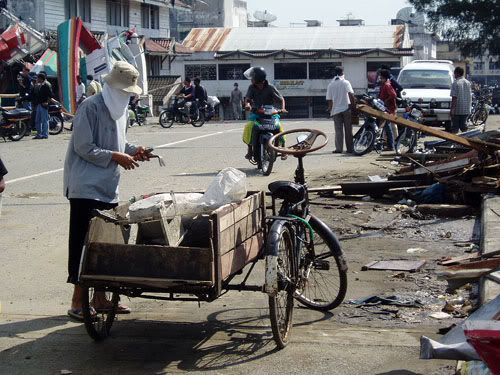
Salvaging for scrap metal
In the midst of the mangled ruins, scavenging and salvaging has already begun. Scrap metal, furniture, and even toys or children bicycles. We also saw people towing and transporting destroyed and deserted vehicles - expensive sedan cars, four-wheel drives, jeeps, and other potentially rewarding scrap metal.
Our guide Iwan tells us that looting was rampant in the more affulent areas in town, where bigger bungalow houses were ransacked. Valuable electricals such as television sets and computers were safe from the floods in the upper floors.
Dead Bodies
We still saw bodies being collected as we passed the city. There were bodies in different colored plastic bags; others were wrapped in bed sheets or thin mattresses. On the day alone we saw at least 10 – 15 bodies being gathered for collection, pilled into open trucks that were already filled with body bags.
Curiously watching the evacuation team looking for bodies under piles of debris and garbage were two brothers about 7-10 years old. Upon enquiry, we found out that the two boys were in the paesantren (Islamic boarding school) not far from the scene of destruction. They were not caught in the floods, but matter-of-factly told us that they lost 13 relatives, including their uncles, aunties, cousins, and grandmother.
We drove further up towards the north and north-west coasts of Aceh to survey damages closer to the epicenter of the 9.0 Ritcher earthquake that struck Aceh two weeks ago.
We were confronted with what we estimated to be about 100 bags of bodies, waiting to be buried in a mass grave. The stench of decomposing human flesh assaulted our senses and churned our stomachs. The unpleasantness was less overwhelming when we covered up our noses and paid more attention to the direction of the wind.
We later used the presence of this foul odor also as an indication of detecting possibly more bodies buried under debris.
North And North-Eastern Coastal Areas - Lokhna, Ujung Batek, Kajhu, Kreung Raya
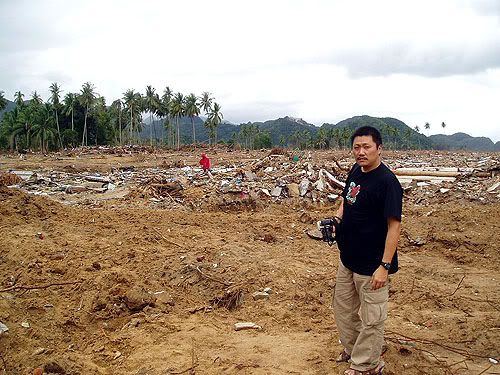
Jo Hann with backdrop - the destroyed Kajhu coastal area
Traveling further north brought us to the coast in an area called Kajhu.
Debris lined the coastal road, of which once perhaps was hugged by long stretches of white sandy beaches. The magnitude of the destruction and debris spread out across the area was shocking. It was a alarming realization when we started imagining how many houses stood here 15 days ago. The disturbing scenery hardly varied for the next two or three kilometers along the coast – everything was destroyed, flattened, and wiped out.
It was unsettling to think of the number of lives that perished in area this large within mere 15 minutes that the tsunami took, after the earthquake that struck on Dec 26 2004.
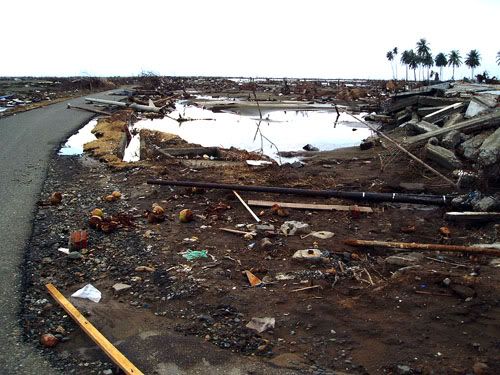
Kilometers of Kajhu houses destroyed
We did a rough estimate – if there were about 5,000 houses in Kajhu, and if each house had one or two families with five family members each...? The total number of lives swept away was stupefying.
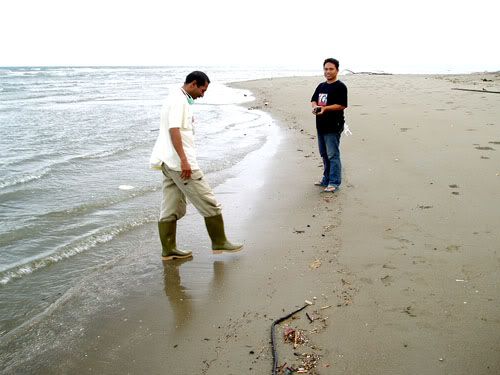
KSKBA volunteers surveying the Ujung Batek beach
Passing through an area that appeared to be a recreational spot, we saw a surviving signboard that proclaimed it to be “Taman Recreasi Ujung Batek.” The only other living thing here was perhaps the tall coconut trees lined along the stretch of the beach. We noticed that the coconut fronds were an unusual greenish-yellow color, perhaps caused by contaminated salty sea water that was churned out of the deep sea. It also indicated the height achieved by the mass of sea water when the waves struck.
Krueng Raya is also along the north coast of Aceh, but was otherwise quite unaffected since it laid on higher land. Many makeshift refugee camps sprung up in response to mass exoduses of survivors who fled for safety. Temporary huts were constructed out of wooden planks and other materials. As with many other temporary refugee camps, clean portable water and proper sanitation was a main priority to prevent outbreaks of diseases and for general hygienic living.
These camps also built road posts to solicit donations and other items from passing vehicles. In some of the camps, these posts were managed by children barely of the school-going age. Although they had smiles on their faces and remained playful at times, one could hardly imagine the trauma they suffered, experiencing such a tragedy at that age.
The calamity in Aceh caused by the earthquake and tsunami is horrifying. But seeing the suffering of the people and the children is especially heartbreaking.
Tan Jo Hann. (Jan 11. 2005)
SEAPCP-KOMAS team
KSKBA Command Post
Medan Sumatra
-------------
Read Day 1, Day 2, Day 3


<< Home